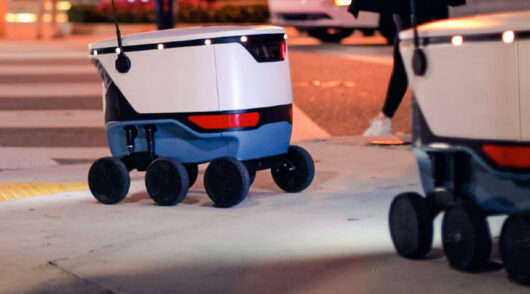After so much Covid-19 disruption and damage, the National Retail Federation’s (NRF) Big Show returned to the Big Apple with an equally big bang last week.
Retailers big and small from around the world, including Australia, came together after a two-year hiatus to hear from the sector’s biggest changemakers, experience the latest innovations, and be inspired by the latest trends, technologies and strategies that will shape the future of retail.
The keynotes were unexpected, thought provoking and created enriching conversations on the expo floor. One highlight was a near-capacity crowd on 16 January for a conversation with decorated Olympic gymnast and advocate Simone Biles, who said: “Everybody’s path to success is not straight, and everybody’s going to have hardships, but I think what matters is the way you go about it.”
Keynotes from Whole Foods, Lowe’s and Petco also resonated strongly. They covered how brands can provide elevated and curated customer experiences and how clear differentiation, and even re-invention, can be critical to meeting consumer demand and providing a sustainable future for retailers.
If one recurring theme stood out, it was the importance of the deep and connected customer experience, one that is built authentically and is sustainable in meeting the consumer when, where and how they want.
Consumer expectations are evolving faster than ever, retailers are being challenged like never before, and NRF presented a number of themes and trends worth noting for the sector here in Australia. Here are some of the highlights.
In-store innovation
Retailers continue to overhaul legacy systems and integrate in-store tech at pace, with one goal – a seamless customer experience. As consumers return to stores post-pandemic, they are seeking out intuitive and personalised interactions that surprise and delight, with the option for frictionless self-service.
AI-driven technologies such as chatbots, automated customer service, and automated inventory management are set to revolutionise the retail industry and the way businesses interact with their customers.
The grocery and supermarket sector has truly led the pack in seamless retail, as the first to normalise self-serve checkouts, and it continues to act as pioneers in the frictionless experience space, with innovations such as Amazon Go’s smart store – no lines, no check out, just grab and go.
The in-store experience of the future
Brand interactions tailored to individual consumers have been shown to build loyalty, and to keep up with consumer expectations, the industry needs effective analytics and digital tools that make integrated channels possible. Retailers are sitting on a wealth of data that can be leveraged to predict behaviours, opening the door to personalised experiences that can be accessed at any brand touchpoint.
On this theme, Shopify president Harley Finkelstein said at NRF: “It didn’t matter whether someone bought it in-store or online. What mattered was, were we serving the consumer in the way the consumer preferred?”
Mattel is also finding ways to tap into communities with product innovation that is thoughtful and purpose-led, predicting trends and creating products and elevated curated experiences aimed at building a community and fan base.
The sales associate of the future
The sales associate is no longer a person behind the counter, but rather a customer service expert with a range of technological skills. With the rise of online shopping, they must be digitally savvy, able to build relationships with customers and provide them with the right information. They must use chatbots, virtual assistants and other digital tools to provide personalised customer experiences and service, and make more informed decisions about stocking and pricing.
Operational effectiveness also centres on the store associate. With self-serve on the rise, they are taking on a broader role. Retailers are recognising and making investments into upskilling and supporting a happier, more efficient workforce.
Walmart’s US president and CEO John Furner shared how the company provides access to Walmart Academy, where associates can learn the skills they need to succeed at work, through free training on everything from leadership to technical skills to a personal craft in which they are interested.
Collaborative sustainability for retail
A key trend here is the focus on reducing operational carbon footprint. Retailers need to invest in reusable packaging systems and promote sustainable product packaging. Another shift is towards more sustainable production processes, such as investing in renewable energy sources and using more sustainable recycled or recycled-content materials.
Retailers should also move towards a circular economy by investing in programs to reduce and reuse waste, as well as programs to recycle and repurpose. As consumers become more discerning and demanding on this front, it is essential for businesses to understand their customers’ needs and preferences in this space.
Another big trend is a ‘nature positive’ approach. With more than a third of the food produced and sold around the world influenced by a small number of food companies and retailers, those large players have a huge opportunity to drive positive outcomes for nature preservation and restoration. The Walmart and Seventh Generation collaboration is an excellent example of the power of sustainable partnerships and co-creating value on both sides. Walmart and the Walmart Foundation have also set a goal to help protect, restore or more sustainably manage at least 200,000 square kilometres of land and 2.6 million square kilometres of ocean by 2030.
A fundamental rethink
Fulfilment was challenging for many in 2022. Options have expanded exponentially, with dark stores, micro-fulfilment, grab-and-go, click-and-collect and pop-ups entering retailers’ everyday vernacular and offerings.
This was a key theme at NRF, and one that also emerged in Deloitte’s 2023 Retail Outlook, with eight in 10 retail executives saying they plan to make moderate to major investments to modernise their supply chains in 2023.
Data is key to optimising the customer experience. Available inventory and its location, consumer habits and preferences, and up-to-the-minute fulfilment status updates need to be integrated to create positive brand interactions.
Macy’s, for example, has overhauled its supply chain. Collaboration has been key, as its chairman and CEO Jeff Gennette explained. It has worked with suppliers on freight logistics, and with shipping giant UPS to optimise last mile solutions. Macy’s also converted approximately 92,900sqm of unused shop floor into 35 regional warehouses, reducing delivery distances to their American customers, and established micro-pop ups that have created new paths to fulfilment and a new, streamlined way for consumers to interact with the brand.
We’ve all heard about the many challenges that both retailers and consumers face – from inflation and cost-of-living pressures, to supply-chain issues and geopolitical factors. These challenges are triggering a fundamental rethink of retail product and service portfolios, sourcing and production methods, and channels to market.
A resilient industry on display
At NRF, I saw an industry that is more than up to these challenges, one that is excited, confident, ready to challenge and to succeed. Operators are doing this by keeping the end in mind – the consumer – and focusing on their concerns and evolving needs and wants.
Walking the neighbourhoods of Chelsea, SoHo and Brooklyn, I saw unique storefront designs, a car dealership with a Michelin Star restaurant, hologram installations, designer collectives, outdoor equipment re-supply and trade-in, perfumery bars, and even NFT video booths that served as reminders of just how animated and clever brands are at reimaging local neighbourhoods and reinvigorating and attracting new customers to their communities.
Most importantly, what I saw was the strength of retailer perseverance and resilience, a willingness to lead from the front, to be agile, to innovate and to excite. It was eye candy for the senses, and we are all returning sweeter than ever.






